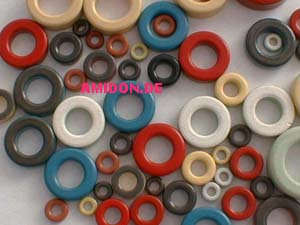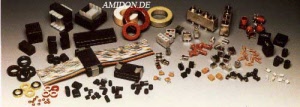 |
IRON POWER CORES
IRON POWDER MATERIALS
MATERIAL #0 (µ=1):
Most commonly used for frequencies above 100 MHz. Available in toroidal form only. Note: Due to the nature of this material the inductance resulting from the use of a given AL value may not be as accurate as we would like. Inductance vs. number of turns will vary greatly depending upon the winding technique.
MATERIAL #1 (µ=20):
A Carbonyl 'C' material, very similar to material #3 except that it has higher volume resistivity and better stability. Available in toroidal form and shielded coil form.
MATERIAL #2 (µ=10):
A Carbonyl 'E' iron powder material having high volume resistivity. Offers high 'Q' for the 2 MHz to 20 MHz frequency range. Available in toroidal form and shielded coil form.
MATERIAL #3 (µ=35):
A Carbonyl 'HP' material having excellent stability and good 'Q' for the lower frequencies from 50 KHz to 500 KHz. Available in toroidal form and shielded coil form.
MATERIAL #6 (µ=8):
A Carbonyl 'SF' material. Offers very good 'Q' and temperature stability for the 20 to 50 MHz frequency range. Available in both toroidal and shielded coil form.
MATERIAL #7 (µ=9):
A Carbonyl 'TH' material. Very similar to the #2 and #6 materials but offers better temperature stability than either. Available in both toroidal and shielded coil form.
MATERIAL #10 (µ=6):
A powdered iron 'W' material. Offers good 'Q' and high stability for frequencies from 40 MHz to 100 MHz. Available in toroidal form and shielded coil form.
MATERIAL #12 (µ=4):
A Synthetic oxide material which provides good 'Q' and moderate stability for frequencies from 50 MHz to 200 MHz. If high 'Q' is of prime importance this material is a good choice. If stability is of a prime importance, consider the #17 material. The #12 material is available in all sizes up to T94, in toroidal form. Not available in shielded coil form.
MATERIAL #15 (µ=25):
A carbonyl 'GS6' material. Has excellent stability and good 'Q'. A good choice for commercial broadcast frequencies where good 'Q' and stability are essential. Available in toroidal form only.
MATERIAL #17 (µ=4):
This is a new carbonyl material which is very similar to the #12 material except tatar it has better temperature stability. However, as compared to the #12 material, there is a slight 'Q' loss of about 10% from 50 MHz to 100 MHz. Above 100 MHz, the 'Q' will gradually deteriorate to approximately 20% lower. It is available in both toroidal form and the shielded coil form.
MATERIAL #26 (µ=70):
A Hydrogen Reduced material. Has highest permeability of all of the iron powder materials. Used for EMI filters and DC chokes. The #26 is very similar to the older #41 material but can provide and extended frequency range. See AC Line Filter and CD Choke sections for size, permeability and frequency range information.
MATERIAL #36 (µ=75):
A Hydrogen Reduced material. Has highest permeability of all of the iron powder materials. Used for EMI filters and DC chokes. The #36 is very similar to the older #41 material but can provide and extended frequency range. See AC Line Filter and CD Choke sections for size, permeability and frequency range information.
